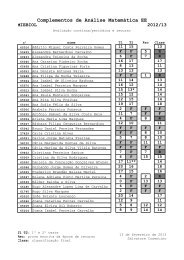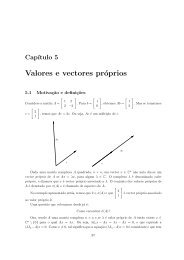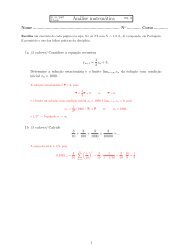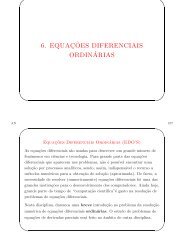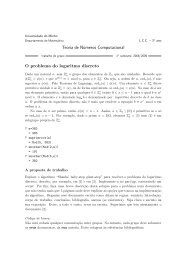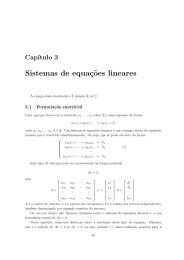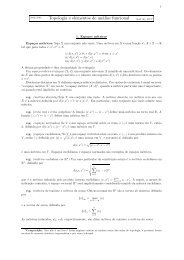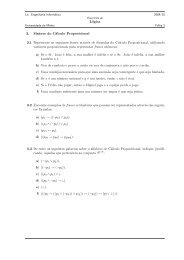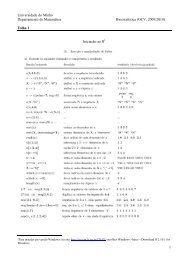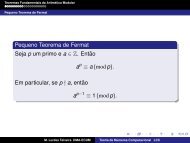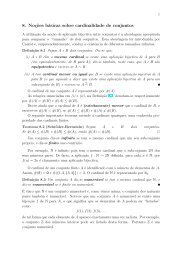My title - Departamento de Matemática da Universidade do Minho
My title - Departamento de Matemática da Universidade do Minho
My title - Departamento de Matemática da Universidade do Minho
You also want an ePaper? Increase the reach of your titles
YUMPU automatically turns print PDFs into web optimized ePapers that Google loves.
16 ERGODICITY AND CONVERGENCE OF TIME MEANS 105<br />
statement that Lebesgue almost any real number is normal in every base m ≥ 2, is due to Emile<br />
Borel (1909).<br />
It is not so easy to give examples of normal numbers, actually of series whose sum is a normal<br />
number. Much more difficult is to show that a “given” number, such as π, √ 2 or e ..., is normal.<br />
Here we quote Mark Kac: 35<br />
“As is often the case, it is much easier to prove that an overhelming majority of objects<br />
possess a certain property that to exhibit even one such object. The present case is<br />
no exception. It is quite difficult to exhibit a ‘normal’ number! The simplest example<br />
is the number (written in <strong>de</strong>cimal notation) x = .1234567891011 . . . where after the<br />
<strong>de</strong>cimal point we write the positive integers in succession. The proof that this number<br />
is normal is by no means trivial.”<br />
Continued fractions and Gauss map.<br />
to be <strong>do</strong>ne<br />
16.4 Unique ergodicity<br />
Unique ergodicity. A homeomorphism f : X → X of a compact metric space (X, d) is uniquely<br />
ergodic if it admits one, and only one, invariant Borel probability measure µ. The above discussion<br />
implies that this unique invariant measure is ergodic.<br />
This notion is the probabilistic counterpart of minimality, and in<strong>de</strong>ed both minimality and<br />
unique ergodicity are often observed simultaneously (this means that, although equivalence of the<br />
two is false, it is not easy to think at a couterexample!). Observe that we <strong>de</strong>fined unique ergodicity<br />
in the context of continuous transformations. The reason is that this notion is interesting due to<br />
the following<br />
Oxtoby’s theorem. Let f : X → X be a homeomorphism of a compact metric space X. The<br />
following statements are equivalent:<br />
i) f is a uniquely ergodic,<br />
ii) there exists an invariant Borel probability measure µ such that, for any continuous observable<br />
ϕ, the time averages ϕ (x) exist and are equal to ∫ ϕdµ for any initial condition x ∈ X,<br />
X<br />
iii) there exists an invariant Borel probability measure µ such that, for any continuous observable<br />
ϕ, the convergence<br />
1<br />
n∑<br />
ϕ ( f k (x) ) ∫<br />
→ ϕdµ<br />
n + 1<br />
k=0<br />
as n → ∞ holds and is uniform in x ∈ X.<br />
X<br />
Kronecker-Weyl equidistribution theorem.<br />
ergodic.<br />
An irrational rotation of the circle is uniquely<br />
Proof. In<strong>de</strong>ed, let +α : x + Z ↦→ x + α + Z be an irrational rotation. We must check that time<br />
means of continuous observables ϕ converge uniformly to the average ∫ ϕdl, where l is Lebesgue<br />
probability measure on the circle. Since, according to Weierstrass theorem, trigonometric polinomials<br />
are <strong>de</strong>nse in the space of continuous functions of the circle, it suffices to check that the above<br />
holds for any of the functions x ↦→ ϕ k (x) = e i2πkx with k ∈ Z. A computation gives, for k ≠ 0,<br />
1<br />
n∑<br />
ϕ j<br />
((+α) (x)) ∣ ∣ ∣∣∣∣ j =<br />
1<br />
n∑ ∣∣∣∣∣<br />
∣n + 1<br />
e i2πkjα ≤ 2<br />
∣n + 1<br />
n + 1 · 1<br />
|1 − e i2πkα | → 0<br />
j=0<br />
j=0<br />
uniformly in x, while the time averages of ϕ 0 are constant and equal to 1. Hence, the time means<br />
of each ϕ k converge uniformly to their space means as times goes to infinity, and we are <strong>do</strong>ne. The<br />
35 Mark Kac, Statistical in<strong>de</strong>pen<strong>de</strong>nce in probability, analysis, and number theory, Carus Math. Monographs, 12,<br />
New York 1959 (pag. 18).



